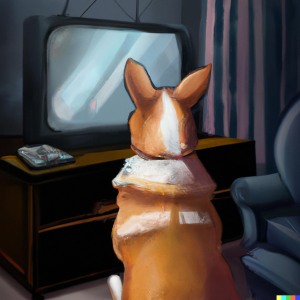What is your dog thinking? Scientists reveal how dogs see the world
- Replies 5
Here at the SDC, we love our furry friends. You can even meet the ‘Pawesome’ team by clicking here. We reckon that even the iciest heart can be melted by a dog’s affectionate and loving look, or their adorable and loyal companionship when we kick back on the couch for some TV time. But have you ever stopped to wonder what exactly your dog is thinking?
Neuroscientists from the Canine Cognitive Neuroscience Lab at Emory University, USA, performed a study on how dogs perceive their surroundings, and their findings may surprise you!
It’s a fairly well-known fact that, compared to humans, dogs have a much more sensitive sense of smell due to the regions of the brain allocated to processing scent information. Their vision, on the other hand, is vastly different from ours and not as well understood.
While the average human being possesses three types of cone cells in their eyes, dogs possess only two. This explains why they are only able to perceive the colours blue and yellow (contrary to popular belief that it’s black & white).

The verdict is in - dogs definitely watch TV, according to science. But they focus on different things. Source: OpenAI
Researchers also tested whether dogs can visually perceive the world similarly to humans. The study showed a couple of brave test subjects 30-minute video clips of ‘stimulating content’ (including clips of dogs running around, humans interacting with each other and patting dogs, vehicles passing by, a deer crossing a path, and a cat in a house - all of which we think sound absolutely scintillating if you’re a dog) and measured the results using an MRI machine.
It was revealed that the dog’s brains are much more attuned to actions rather than the objects responsible for them. In other words, dogs may perceive and analyse environmental threats in a completely different manner to humans, and while they were undoubtedly ‘watching’ the screen, the things they were focusing on were likely very different to what we’d focus on.
'We humans are very object-oriented,' said corresponding author Professor Gregory Berns.
'There are 10 times as many nouns as there are verbs in the English language because we have a particular obsession with naming objects.
'Dogs appear to be less concerned with who or what they are seeing and more concerned with the action itself.'
He added: 'It makes perfect sense that dogs’ brains are going to be highly attuned to actions first and foremost.’
'Animals have to be very concerned with things happening in their environment to avoid being eaten or to monitor animals they might want to hunt.’
'Action and movement are paramount.'
The subjects were Bhubo, a four-year-old male Boxer-mix, and Daisy, an 11-year-old female Boston terrier-mix.
Anyone who’s had the (mis)fortune of sitting in an MRI machine knows how noisy and claustrophobic it can be, so for this pioneering study, the dogs had to be specially trained to enter and lie inside the device completely unrestrained. ‘They didn’t even need treats’, said one of the study authors. (We think they deserved them!)
‘While our work is based on just two dogs, it offers proof of concept that these methods work on canines,’ neuroscientist Erin Phillips said.
‘I hope this paper helps pave the way for other researchers to apply these methods on dogs, as well as on other species, so we can get more data and bigger insights into how the minds of different animals work.’
So, next time your dog is watching TV with keen interest, don’t be surprised! And we here at the SDC would like to extend a special thank you (and scratch behind the ear) to Bhubo and Daisy for helping to expand the bounds of science!
Neuroscientists from the Canine Cognitive Neuroscience Lab at Emory University, USA, performed a study on how dogs perceive their surroundings, and their findings may surprise you!
It’s a fairly well-known fact that, compared to humans, dogs have a much more sensitive sense of smell due to the regions of the brain allocated to processing scent information. Their vision, on the other hand, is vastly different from ours and not as well understood.
While the average human being possesses three types of cone cells in their eyes, dogs possess only two. This explains why they are only able to perceive the colours blue and yellow (contrary to popular belief that it’s black & white).

The verdict is in - dogs definitely watch TV, according to science. But they focus on different things. Source: OpenAI
Researchers also tested whether dogs can visually perceive the world similarly to humans. The study showed a couple of brave test subjects 30-minute video clips of ‘stimulating content’ (including clips of dogs running around, humans interacting with each other and patting dogs, vehicles passing by, a deer crossing a path, and a cat in a house - all of which we think sound absolutely scintillating if you’re a dog) and measured the results using an MRI machine.
It was revealed that the dog’s brains are much more attuned to actions rather than the objects responsible for them. In other words, dogs may perceive and analyse environmental threats in a completely different manner to humans, and while they were undoubtedly ‘watching’ the screen, the things they were focusing on were likely very different to what we’d focus on.
'We humans are very object-oriented,' said corresponding author Professor Gregory Berns.
'There are 10 times as many nouns as there are verbs in the English language because we have a particular obsession with naming objects.
'Dogs appear to be less concerned with who or what they are seeing and more concerned with the action itself.'
He added: 'It makes perfect sense that dogs’ brains are going to be highly attuned to actions first and foremost.’
'Animals have to be very concerned with things happening in their environment to avoid being eaten or to monitor animals they might want to hunt.’
'Action and movement are paramount.'
The subjects were Bhubo, a four-year-old male Boxer-mix, and Daisy, an 11-year-old female Boston terrier-mix.
Anyone who’s had the (mis)fortune of sitting in an MRI machine knows how noisy and claustrophobic it can be, so for this pioneering study, the dogs had to be specially trained to enter and lie inside the device completely unrestrained. ‘They didn’t even need treats’, said one of the study authors. (We think they deserved them!)
‘While our work is based on just two dogs, it offers proof of concept that these methods work on canines,’ neuroscientist Erin Phillips said.
‘I hope this paper helps pave the way for other researchers to apply these methods on dogs, as well as on other species, so we can get more data and bigger insights into how the minds of different animals work.’
So, next time your dog is watching TV with keen interest, don’t be surprised! And we here at the SDC would like to extend a special thank you (and scratch behind the ear) to Bhubo and Daisy for helping to expand the bounds of science!







